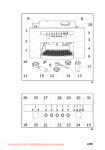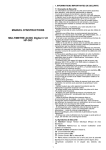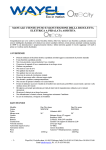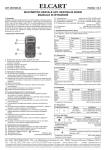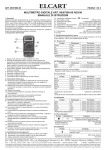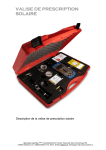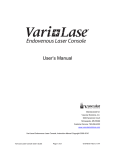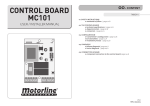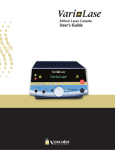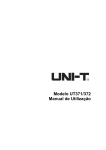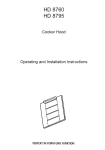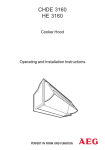Download Electrolux PE 8036-M User's Manual
Transcript
PE 8036-M Espresso coffee machine AEG Hausgeräte GmbH Postfach 1036 D-90327 Nürnberg http://www.aeg.hausgeraete.de © Copyright by AEG Operating and Installation Instructions A B 2 C D E/1 E/2 F/1 F/2 3 4 G H I/1 I/2 I/3 L M/1 N/1 O/1 M/2 N/2 O/2 5 6 P/1 P/2 Q/1 Q/2 Q/3 Q/4 Q/5 Q/6 Q/7 Q/8 R/1 R/2 7 8 R/3 R/4 R/5 R/6 R/7 R/8 S/1 S/2 S/3 9 ENGLISH INDEX 1. 2. 3. 4. 5. 6. 7. 8. 9. 10. 11. 12. 13. 14. 15. Description of the Coffee machine Description of the control panel Recommendations Instructions for the first use Accessories (already included) Coffee drawer (optional) Coffee Hot water Steam Recipes Cleaning and servicing Installation Appliance malfunction Technical specifications Declaration of guarantee terms 1. DESCRIPTION OF THE COFFEE MACHINE (FIG. A) 1. 2. 3. 4. 5. 6. 7. 8. 9. 10. 11. 12. 13. 14. 15. 16. 17. 10 Filter-holder ring nut Steam pipe Coffee pressing tool Coffee grinder button Coffee measuring device Cabinet locking button Drip tray Coffee container Water reservoir Grinding regulation knob Filter-holder 1-cup-filter 2-cup-filter Scoop One-way nozzle Two-way nozzle Brita filter 2. DESCRIPTION OF THE CONTROL PANEL (FIG. B) 18. 19. 20. 21. 22. 23. 24. 25. 26. 27. 28. 29. 30. 31. Steam tap knob Coffee measuring knob Switch button (ON/OFF) Coffee button Hot water button Steam button Light key “Power ON” Warning light Water temperature indicator Coffee indicator Water indicator Steam indicator Light indicator Coffee measuring indicator (1 short- ,long coffee, 2 short- ,long coffees) 2. RECOMMENDATIONS The use of this appliance is very easy. However, please, read carefully and thoroughly this instructions manual before installing and operating your coffee machine, in order to avoid making mistakes, to get better results and to respect the environment. OPERATING WARNING: To obtain an ideal coffee the filtering unit has to be very hot, therefore please use the machine with extreme care to avoid being scalded. · · · · · · This appliance must be used only by adults. Make sure that the appliance will be out of the reach of children. Do not attempt to modify this appliance in any way. Always keep the appliance clean. The external parts of this appliance become very hot while it is on and they will remain hot after the appliance is switched off. Keep children out of reach until the parts have cooled down completely. Before cleaning or servicing, make sure that the appliance is disconnected from the electricity supply. If there is something wrong, this cannot be solved by yourself. Repairs made by inexperienced people can cause damages and accidents. Read the contents of this manual and, if you do not find the information you need, please contact your nearest Service Force Centre. This appliance must only be serviced by an authorised engineer. Always insist on genuine spare parts. FOR INSTALLATION AND SERVICING · · This appliance must only be installed by a qualified electrician or competent person. Ensure that the appliance is disconnected from the electricity supply before any servicing or cleaning is carried out. After having taken the appliance out of the packaging check that it · has not suffered damage during transportation and that the power cable or the plug is in good condition. If the appliance is damaged, contact your retailer immediately. The Manufacturer declines any responsibility for failure to observe these safety warnings. HOW TO RESPECT THE ENVIRONMENT PACKAGING · All the packaging materials used are environmentally friendly and can be recycled. Please discard of all packaging material with due regard for the environment. OLD APPLIANCES · At the end of the appliance’s useful life, please discard of it at an authorised disposal site or recycling centre. · Contact your local Council or Environmental Health Office for the address of your nearest recycling centre. · Before discarding the appliance, cut off the mains power cable so that it can no longer be connected to the mains supply. It is very important to keep this instruction book with the appliance for future reference. If the appliance is sold or transferred to another person, make sure that the instruction book is given to the new user, so that they can become familiar 11 with the appliance’s functions and with the recommendations given. CE This appliance is in accordance with the directive BT 73/23 § Electricity safety norms EN 603351 (August 1995 - Safety for electrical household appliances and similar – General Norm) and EN 60335-2-15 (April 1996 – Specific Norms concerning heating liquids appliances). § Directive EMC 89/336 in conformity with the following norms: 55014-1 55014-2 61000-3-2 61000-3-3 - FILL UP THE COFFEE BEANS CONTAINER · · · 4. INSTRUCTIONS FOR THE FIRST USE · FILL UP THE WATER RESERVOIR · · · · · · - 12 Push the cabinet locking button (E/1). Take the coffee machine out of the housing using the special telescopic runners (E/2). Fill up the water reservoir (G) situated on the left side of the appliance with 2,5 litres of water. Push the coffee machine back into the housing (F/1) and push the locking button (F/2). The hardness of the water: Before filling up the water reservoir, make sure that the Brita filter (A-17) has been soaked for at least 30 min. in cold water (please follow the instructions indicated on the filter packaging). After that, insert the filter into the reservoir (see chapter 12. Installation “Water Connection”). If the machine will not be used for long periods, change the water in the reservoir and empty the boiler by making the machine dispense about half a litre of water (see chapter 8. Hot water). Push the cabinet locking button (E/1). Take the coffee machine out of the cabinet using the special telescopic runners (E/2). Put into the coffee container, situated on the right side of the appliance, about 200 gr. of coffee beans (H). Push again the coffee machine into its relative seat as before (F/1) using the special runners. Push the locking button again (F/2) so that the machine will be secured in the housing. STARTING PROCESS · · Switch the coffee machine on by pushing the ON button (B-20). The red warning light (B-25) indicates the appliance is connected to the mains supply (lamp illuminated = ON/ lamp out = OFF). Set the machine to dispense hot water (see paragraph 7. Hot water) and wait until the air contained in the boiler has completely passed through the steam pipe (A-2) and water · comes out (repeat this operation as many times as necessary) and then set the knob to the off position (B-18). Meanwhile the water temperature indicator lights up (B-26). It indicates the water heating process in the boiler. When the light goes out it means that the machine has reached the right temperature and is ready for coffee. · · · RESET OF STANDARD VALUES · · The coffee machine leaves the factory set for the ideal Italian espresso coffee, as approved by the coffee University of Naples and in accordance with ILLY standard. The setting values for long coffee, on the contrary, are in accordance with German standards. If you wish to reset these standard values, just turn the machine on by pushing the ON/OFF button (B-20) and the steam button (B-23) at the same time. The flashing indicator lights show that the standard values have been reset. REGULATION OF THE GROUND COFFEE · · The coffee machine leaves the factory already set on an ideal coffee grinding level. Push the cabinet locking button (E/1). · Take the coffee machine out of the housing using the special telescopic runners (E/2). The grinding level can be changed using the special regulation knob (A-10). By turning the knob in a clockwise direction the grinding becomes fine and the coffee stronger. By turning the knob anti-clockwise the grinding becomes coarse and the coffee lighter. Push the coffee machine back into the housing (F/1), using the special telescopic runners. Push the cabinet locking button (F/2) again so that the machine is secure. PROGRAMMING OF THE GROUND COFFEE MEASURE · · · The coffee machine leaves the factory already set to dispense the ideal measure for 1 cup of espresso. The ground coffee measure can be increased or reduced and once selected, the machine can be programmed to remember this measure. The ground measure that can be programmed only refers to one single cup of coffee. Grinding time for double coffee comes out automatically after having memorised a single coffee. Set the coffee measuring knob (B19) on the “small cup” light on the left (B-31), insert the 1-cup-filterholder (A-11 / A-12) under the special funnel (A-5) and gently push and hold the grinder button to make the grinder work (A-4). After 10 seconds the grinder will start working and it is possible to 13 · programme the coffee measure. Once the required ground coffee measure has been achieved (recommended measure 7g, corresponding to 6 seconds of grinding) just release the grinder button (A-4) and the measure will be automatically memorised. Useful Advice: be careful to use the right filter suitable for the required ground coffee measure (A-12/13). PROGRAMMING THE AMOUNT OF WATER TO BE DISPENSED · · · · · PROGRAMMING THE AMOUNT OF COFFEE TO BE DISPENSED · · · · · The coffee measure can be set as desired. Set the coffee measuring knob (B19) on the required “coffee measure” light and grind a certain measure of coffee in the filterholder. Insert the filter-holder (A11) in the ring nut (A-1), and put under it one or two cups according to the selected programme. To access the programming stage Keep the coffee button pressed (B-21) for at about 5 seconds. When the coffee starts coming out, release the button. (The “coffee measure” light will be flashing)(B-27). When the required quantity has been dispensed push the button again (B-21) and it will be automatically stored in the control unit. 5. ACCESSORIES · · · The coffee machine is equipped with one filter-holder (A-11) on which two filters can be inserted: 1-cup (A-12) 2-cup (A-13) If using paper pods, only use a 1cup-filter. There is also a measure (A-14), which is useful in order to know the exact measure used for ground coffee (about 7,2 g). The machine also has two nozzles, a 1-(A-15) and a 2-way nozzle (A-16), that should be screwed onto the filter-holder (A11) according to the number of cups of coffee required. 6. DRAWER (OPTIONAL) · 14 Put a container under the steam pipe (A-2) Turn the steam knob anticlockwise (B-187). To access the programming stage Keep the water button pressed (B22) for about 5 seconds. Release the button when the water starts coming out. When the required quantity is reached push the hot water button again (B-22) and it will be automatically stored in the control unit. The machine can also have an optional well-equipped drawer with a stainless steel front panel, - PES 8036-m. The drawer has a lot of useful compartments: One large compartment for cups and saucers A basin for coffee-grounds A compartment for all accessories (filters, measure). A tray USE OF COFFEE PODS (E.S.E SYSTEM) · 7. COFFEE USE OF COFFEE · · · · · · · Set the coffee knob (B-19) to the required coffee measure. Insert the filter-holder (A-11) under the Coffee measuring device (A-5). By pressing the relative button (A-4), the previously programmed coffee measure for one or two cups will automatically come out. Once the required measure has been dispensed, press the ground coffee with the pressing tool (A3). Insert the filter-holder (A-11) correctly into the ring nut (A-5) making sure that it is perfectly secure: turn the filter-holder handle from left to right. Put one/two coffee cup/s under the filter-holder nozzle (A-15/16). Check that the red light of the water temperature indicator (B26) is out or wait until it goes out. Push the coffee button (B-21) and the coffee measure dispensed will be exactly the same as the one selected and programmed. Take the filter-holder out of the ring nut and remove the ground coffee. · · · · · · · · E.S.E. system means Easy Serving Espresso and corresponds to the international standard for brewing coffee using coffee pods (one throwaway portion of roasted coffee) and a suitable coffee machine. The E.S.E. system is easy, practical and ecological because it doesn’t need particular servicing and it is environmentally friendly. Moreover it is also a hygienic way to drink coffee thanks to its special packaging that avoids coffee coming out and it can be easily removed after use. The machine can work also with pods: one throwaway portion of roasted coffee (for one single coffee only). Turn the knob (B-19) to the required coffee measure (long or short single coffee) and the corresponding light will illuminate. Insert the one throwaway pod into the filter-holder (use the 1cup-filter) Insert the filter-holder (A-11) correctly into the ring nut (A-5) making sure that it is perfectly secure: turn the filter-holder handle from left to right. Put the cup under the 1-way nozzle (A-15). Check that the red light of the water temperature indicator (B26) is out or wait until it goes out. Push the coffee button (B-21) and the coffee will be dispensed. Take the filter-holder out of the ring nut and remove the pod. 15 HOW TO PREPARE AN EXCELLENT ESPRESSO · · · · · · · 16 To obtain an excellent espresso, a clean coffee machine and the right temperature are the most important elements. Make sure that filter, filter-holder and ring nut are always clean. Except when the machine will not be used for very long periods, it should be kept on with the filterholder inserted into the ring nut to keep it warm. Warm the cups by filling them up with a little bit of water by pushing the coffee button. In that way the water remained in the boiler will come out and the filterholder will be warmed. After having made the last cup of coffee, clean the filter-holder by making a coffee without beans in order to remove all the remains of ground coffee, that can change the taste of the next coffee. To obtain an excellent espresso the brewing time should be about 20- 25 seconds. Elements that can influence the brewing time are the grinding level of the coffee, the ground coffee measure and how much the coffee has been pressed. The machine is set to obtain a good-quality coffee. If necessary, the grinding level can be changed as well as the ground coffee measure, (see chapter 4. How to behave during the first process) in order to obtain an excellent espresso. Useful advice: coffee is a hygroscopic element that means that its characteristics are strictly connected with the weather (humidity). Remember that the coffee should be ground coarser if there is a great quantity of humidity in the air or it will become thick and will come out with difficulty; with a dry climate on the contrary, the coffee should be ground finer. 8. HOT WATER · · · · Put a container under the steam pipe (A-2). Turn the steam knob anticlockwise (B-18). Push the hot water button (B-22) and the amount of water dispensed will be the same as previously programmed. Close the steam knob (B-18) 9. STEAM HEATING LIQUIDS · · · · Press the steam button once (I/1); both the steam indicator (B-29), and the water temperature indicator will be ON (B-26). Wait until both of them go out (I/2). Push the steam button again in order to stop producing steam (B-23). To check if the steam has been produced push again the steam button (I/3); if the water temperature indicator l (B-26) remains out it means that steam is ready to come out. Put under the steam pipe (A-2) a container with the liquid that has to be warmed. · · · · · Turn the steam knob anticlockwise (B-18) Wait until the liquid becomes warm. Close the steam knob (B-18) Attention: never make coffee when the steam is ready to come out, if this is the case, reset the water level in the boiler as explained in the next point. Attention: after every steam emission push the hot water button (B-22) without opening the steam knob (B18) (in this way the water level in the boiler will be reset). · · · Close the steam knob (A-18) Attention: never make coffee when the steam is ready to come out, if this is the case, reset the water level in the boiler as explained in the next point. Attention: after every steam emission push the hot water button (B-22) without opening the steam knob (B18) (in this way the water level in the boiler will be reset). 10. RECIPES ITALIAN CAPPUCCINO HOW TO PREPARE CAPPUCCINO FOAM · · · · · · Press the steam button once (I/1); both the steam indicator (B29), and the water temperature indicator will be ON (B-26). Wait until both of them go out (I/2). Push the steam button again in order to stop producing steam (B-23). To check if the steam has been produced push the steam button again (I/3); if the water temperature indicator (B-26) remains out it means that steam is ready to come out. Put under the steam pipe (A-2) a container with the milk that has to be warmed. Turn the steam knob anticlockwise (B-18) While the steam is coming out move the container up and down, until the milk produces the right foam for your cappuccino. This is a normal espresso coffee with steam-heated milk that gives the coffee a milder flavour and a rich, frothy topping. Serve in a large cup. Pour cold milk into a tall jug and heat it using the steam spout if your machine has one. Add only the froth to the espresso coffee, to do this either tilt the jug slightly rocking it backwards and forwards while you pour or use a spoon to scoop off the froth. You can also add a dusting of cocoa powder to taste. VIENNESE CAPPUCCINO This variation is the result of age-old Austrian tradition. Prepare a 'long' espresso by letting the machine run for longer than usual (3035 seconds), add hot milk followed by whipped cream. Serve in a mediumsized cup (midway between and espresso cup and a cappuccino cup). Decorate with flakes of chocolate. 17 COLD ESPRESSO SHAKE Frothy and extremely refreshing, this makes a pleasant drink on hot days. Prepare an espresso coffee, add sugar and pour into a cocktail shaker with large ice cubes. Shake for a few seconds. Serve in a tumbler or flûte. Move to the refrigerator ½ hour before serving. Serve two-three balls of the ice-cream in a small bowl and decorate with roasted coffee beans. 11. CLEANING AND SERVICING OUTER PARTS IRISH COFFE Any energy-giving tonic. Warm a tall glass and mix eight parts of hot coffee with one part whisky and brown sugar. Gently pour freshly whipped cream over the back of a spoon so that it floats on the coffee: the result is a layer of cool white cream on top of the hot dark coffee. · · DRIP TRAY MEXICAN COFFEE · Intense and exotic. Mix together a portion of double cream, half a teaspoon of cinnamon, a pinch of nutmeg and sugar in a small cup and beat until it becomes frothy. Place a teaspoon of chocolate syrup, a pinch of cinnamon and the coffee into a medium-sized cup and blend together. Top with a teaspoon of vanillaflavoured cream. · CAPPUCCINO ICE-CREAM Heat 2 cups of espresso coffee, ¾ cup of single cream and ½ cup sugar in a pan and bring to boiling point. Leave to cool before placing in the freezer for 4-5 hours. 18 The outer parts of the machine should only be cleaned with sponges or soft cloths to avoid scratching. (L). Under no circumstances should solvents, abrasive powders or steel wool be used. · Remove the drip tray from the machine (M/1,M/2). Make sure that the drip tray is periodically emptied (A-7) to avoid any liquid seeping out that could cause damages to the underlying furniture. The drip tray and grid can be washed in a dishwasher. FILTER / FILTER-HOLDER / RING NUT · Always keep the filter (A-15/16), filter-holder (A-11) and ring nut (A-5) clean. Always Clean away coffee residue because it can change the taste of the next cups of coffee. · · Every month wash the filter and filter holder in the dishwasher. The steam nozzle (A-2) should be periodically cleaned. It could become dirty inside by making cappuccinos. It should be removed (N/1,N/2) and washed with a sponge in warm water. Attention: Before cleaning the steam pipe, always turn the machine off and wait at least 20 minutes after use to allow the steam pipe to cool. This will avoid the risk of burns. WATER RESERVOIR · · · · If the machine is not be used for long periods, change the water in the reservoir and empty the boiler by pushing the coffee button (B21) as many times as necessary. Periodically clean the water reservoir(A-9) to remove the fur. The water reservoir can be washed in a dishwasher. The Brita filter should be replaced after approximately 2000 cups of coffee or at least after six months. BOILER CLEANING CYCLE · · - Like all the appliances that use water, it is possible that fur will appear in the boiler of the coffee machine. Every six months the following process should be carried out: Fill up the water reservoir with 1,5 litres of water also adding half a glass of vinegar or citric acid. Dispense some coffee (see paragraph 6. Coffee), but without using either ground coffee or - - pods, so that only water will come out of the filter holder until the reservoir is completely empty. Fill the reservoir again with cool clean water and repeat the above process (without using coffee as before) in order to rinse the boiler. The coffee machine is now ready for use. 12. INSTALLATION INSTALLING THE MACHINE INTO FURNITURE HOUSING For the machine to operate correctly, it must be installed into a suitable housing unit. In conformity with safety norms, the protection to avoid contacts with the electrical parts and the parts protected only with functional insulation should be guaranteed by a correct insertion of the appliance. All components that guarantee protection, even a cover panel (if the appliance for example is situated at one extremity of the modular furniture), should be well fastened so that they can not be removed without using tools. The appliance should be installed at a certain distance from refrigerator or freezer, because the heat given out from it can impair their functioning. 19 COMPONENTS FOR THE INSTALLATION compensate the internal width of the seat. For obtaining a width of 562/560mm see picture P/1 and P/2. The coffee machine is equipped with the following components for the installation (C): 1. 2. 3. 4. 5. 6. 7. 8. 9. 10. 2 side-plates 1mm 4 side-plates 2mm 2 telescopic runners 1 mains terminal block 1 cabinet lock tongue 1 cabinet locking bar 2 L brackets 2 rectangular washers 1 mains power cable 4 double stickers for fixing the plates 11. 8 screws M4X16 12. 12 self-threading screws 13. 4 washers ELECTRICAL CONNECTION · · Fix the mains terminal block (C4) to the top back left corner of the cabinet (O/1). Connect the mains cable to the terminal block ensuring correct polarity (C/4), and connect the coiled mains input cable between the appliance and the terminal block. USE OF THE SIDE PLATES The width of the cabinet in which the coffee machine should be inserted is determined by the thickness of the cabinet’s sides. To compensate the different possible measurement, the appliance is equipped with 6 plates, 4 are 2mm in thickness and 2 are 1mm. thick. They should be used to 20 INSTALLATION WITHOUT SUPPORT · · · · · · · · · · Put the suitable plates (P/1,P/2) on the both sides of the housing, fixing them with the doublesticker strips (Q/1). Pay attention to the position of the bevel which indicates the right position of the plates. Release the telescopic runners and extract the front section (Q/2) Fix the telescopic runners’ bearings with the screws as shown in picture Q/3 Fix the 2 L brackets as shown in picture Q/4 Install the cabinet locking bar using the rectangular washers and the specific M4 screws as shown in picture Q/5 Install the telescopic runners on the both sides of the machine as shown in picture Q/6 Insert the machine: the telescopic runners should be coupled with the runners‘ bearings which are already fastened on the sides. (Q/7) Check the safety lock clicks when the runners are pushed in. Adjust the cabinet locking bar if necessary, for the correct locking position of the machine, and tighten the screws as shown in picture Q/8 Push the cabinet block button so that the machine will be well fastened (F/2). INSTALLATION WITH SUPPORT · · · · · · · · · · Put the suitable plates (P/1,P/2) on both sides of the cabinet sides, fixing them with the doublesticker strips (R/1) Pay attention to the position of the bevel which indicates the right position of the plates. Release the telescopic runners and extract the front section (R/2) Fix the telescopic runners’ bearings with the screws as shown in picture (R/3) Put the lock bracket in the correct position and fix it with two selfthreading screws onto the base as shown in picture R/4,R/5. Install the telescopic runners on the both sides of the machine as shown in picture R/6 Insert the machine: the telescopic runners should be coupled with the runners ‘ bearings which are already fitted on the sides. (R/7). Ensure the safety lock operates when the runners are pushed in. With the machine completely inserted in the housing use the cabinet locking button (A-6) and check that it functions correctly. Adjust the cabinet locking bracket, if necessary and secure as shown in picture R/8 Push the cabinet locking button so that the machine will be correctly fastened (F/2). WATER CONNECTION · · · · · · · · Push the cabinet locking button (E/1) . Take the coffee machine out of the cabinet using the special telescopic runners (E/2) Remove the lid of the water reservoir (A-9), and take the Brita filter out (A-17) Remove its packaging and soak the filter in cool water for half an hour; then, insert it into the reservoir (S/1) Insert the flexible suction water pipe (the one with the filter) and the ventilation pipe in the special grooves (S/2). Push the pipes into the reservoir end-plate (S/3) Fill up the reservoir with cool water Attention: Only fill the reservoir with cool drinking water: under no circumstances put milk or other liquids! Brita filters can be purchased from our Service Centres, retailers of electric household appliances or retailers of this type of spare parts. 13. WHAT TO DO IF…. If your machine does not function, please ensure that the fault is not caused by: 1. 2. A power failure The water reservoir being empty. If you require a replacement power cable or if your machine requires servicing, please contact your local Service Force Centre. 21 FUSES 14.TECHNICAL SPECIFICATIONS For the general measurement of the coffee machine see pictures. · Width 594 mm · Depth 260 mm · Height 357 mm · Capacity · Net Weight 17 kg · Gross Weight 19 kg · Mains Voltage 230 - 240 V · Total nominal power 1150 W · Heating element input 1000 W · Electric pump input 50 W · Working pressure 12 bar · Fuse 13 A 22 3 litres F1: Fuse Ø5x20mm Vn=250V In=10A F2: Fuse Ø5x20mm Vn=250V In=0,5A 15. DECLARATION OF GUARANTEE TERMS SERVICE & SPARE PARTS If you wish to purchase spare parts or require an engineer, contact your local AEG Service Force Centre by telephoning: 08705 929 929 Your telephone call will be automatically routed to the Service Centre covering your post code area. For the address of you local Service Force Centre or for further information regarding Service Force, please visit the website as www.serviceforce.co.uk When you contact the Service Centre they will need the following information: 1. Your name & address, including post code. 2. Your telephone number 3. Clear and concise details of the fault. 4. The model, serial and production number. This information can be found on the rating plate. The rating plate is on the inner edge of the door on the right. 5. Date of purchase. Please note that it will be necessary to provide proof of purchase for any in guarantee service call. CUSTOMER CARE For general enquiries concerning your AEG appliance or for further information on AEG products please contact our Customer Care Department by letter or telephone at the address below or visit our website at www.aeg.co.uk Customer Care Department AEG Domestic Appliances 55-77 High Street, Slough, Berkshire, SL1 1DZ Tel. 08705 350350 (*) (*) Calls to this number may be recorded for training purposes. In-guarantee customers should ensure that the chapter headed "What to do if...“ has been read, as the engineer will make a charge if the fault is not a mechanical or electrical breakdown. 23 GUARANTEE CONDITIONS AEG offer the following guarantee to the first purchaser of this appliance. 1. The guarantee is valid for 12 months commencing when the appliance is handed over to the first retail purchaser, which must be verified by purchase invoice or similar documentation. The guarantee does not cover commercial use. 2. The guarantee covers all parts or components which fail due to faulty workmanship or faulty materials. The guarantee does not cover appliances where defects or poor performance are due to misuse, accidental damage, neglect, faulty installation, unauthorised modification or attempted repair, commercial use or failure to observe requirements and recommendations set out in the instruction book. This guarantee does not cover such parts as light bulbs, removable glassware or plastic. 3. Should guarantee repairs be necessary the purchaser must inform the nearest AEG Service Force Centre (manufacturer’s service or authorised agent). AEG reserves the right to stipulate the place of the repair (i.e. the customer’s home, place of installation or AEG workshop). 4. The guarantee or free replacement includes both labour and material. 5. Repairs carried out under guarantee do not extend the guarantee period for the appliance. Parts removed during guarantee repairs become property of AEG. 6. The purchaser’s statutory rights are not affected by this guarantee. EUROPEAN GUARANTEE If you should move to another country within Europe then your guarantee moves with you to your new home subject to the following qualifications: * The guarantee starts from the date you first purchased your product. * The guarantee is for the same period and to the same extent for labour and parts as exist in the new country of use for this brand or range of products. * This guarantee relates to you and cannot be transferred to another user. * Your new home is within the European Community (EC) or European Free Trade Area. * The product is installed and used in accordance with our instructions and is only used domestically, i.e. a normal household * The electrical supply complies with the specification given in the rating label. * The product is installed taking into account regulations in your new country. Before you move, please contact your nearest Customer Care centre, listed below, to give them details of your new home. They will then ensure that the local Service Organisation is aware of your move and able to look after you and your appliances. France Germany Italy Sweden UK 24 +33 (0)3 44 62 2929 +49 (0)800 2347378 +39 (0)800 117511 +46 (0)8 672 5360 +44 (0)1753 219899 25 26 A B/1 B/2 B/3 B/4 B/5 B/6 B/7 27 28 B/8 B/9 C/1 C/2 C/3 29 INDEX 1. 2. 3. Description of the coffee drawer Installation Adjustment of the front panel 1. DESCRIPTION OF THE COFFEE DRAWER (PICTURE A) This drawer is optional in the coffee machine. It can be helpful for the user in making coffees or cappuccinos. It can contain all coffee machine’s accessories and has also a basin for coffee grounds as well as an useful tray. 1. 2. 3. 4. 5. 6. 7. Drawer structure Shaped plate Tray Basin for coffee grounds Left runner Right runner 3 self-threading screws 4,8x15 8. 8 self-threading screws 4,8x15 9. 1-cup-filter holder’s seat 10. Measure’ s seat 11. 2-cup-filter holder’s seat 3. INSTALLATION · 30 Attention: Where instructions are marked with an *, please refer to chapter 12 titled “Installation without support”. · · · · · · · · · Position the side plate (*) and fix it with the double-sticker strips. (B1) Fix the coffee drawer’s runners (5-6) with the screws. (B2) Fix the brackets (*) with the screws. (B3) Fix the cross-bar (*) using the correct accessories. (B4) Install the runners (*) of the appliance. (B5) Insert the drawer. (B6) Insert the coffee machine. (B7) If necessary take the coffee machine and the drawer out of the cabinet and adjust the cross- bar (*). (B8) Insert again in the cabinet the coffee machine and the drawer. (B9) 4. ADJUSTMENT OF THE FRONT PANEL If necessary the front panel of the drawer can be adjusted in order to be perfectly aligned to the cabinet and to the other electric household appliances. VERTICAL ADJUSTMENT To adjust vertically the front panel of the drawer release the screw (X-C1), make the necessary adjustments and screw down the screw again. (C1) HORIZONTAL ADJUSTMENT To adjust horizontally the front panel of the drawer release the 2 screws (YC2); after the adjustments screw down the 2 screws again (C2). FIXING THE FRONT PANEL After having made the adjustments, the front panel has to be finally fixed, using the 3 screws (7) that the drawer is equipped with (C3). 31 PE 8036-M PROFI-ESPRESSO-Kaffeeautomat Macchina da caffé espresso Espresso coffee machine AEG Hausgeräte GmbH Postfach 1036 D-90327 Nürnberg http://www.aeg.hausgeraete.de © Copyright by AEG Montage- und Gebrauchsanweisung Manuale d’installazione e d’uso Operating and Installation Instructions
































